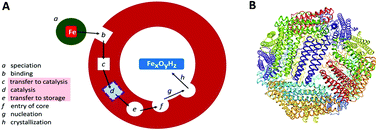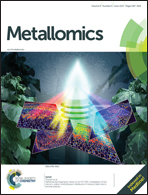The workings of ferritin: a crossroad of opinions
Abstract
Biochemistry of the essential element iron is complicated by radical chemistry associated with Fe(II) ions and by the extremely low solubility of the Fe(III) ion in near-neutral water. To mitigate these problems cells from all domains of life synthesize the protein ferritin to take up and oxidize Fe(II) and to form a soluble storage of Fe(III) from which iron can be made available for physiology. A long history of studies on ferritin has not yet resulted in a generally accepted mechanism of action of this enzyme. In fact strong disagreement exists between extant ideas on several key steps in the workings of ferritin. The scope of this review is to explain the experimental background of these controversies and to indicate directions towards their possible resolution.

- This article is part of the themed collections: Iron in Biology and Metallomics 2017 Most Downloaded Articles


 Please wait while we load your content...
Please wait while we load your content...